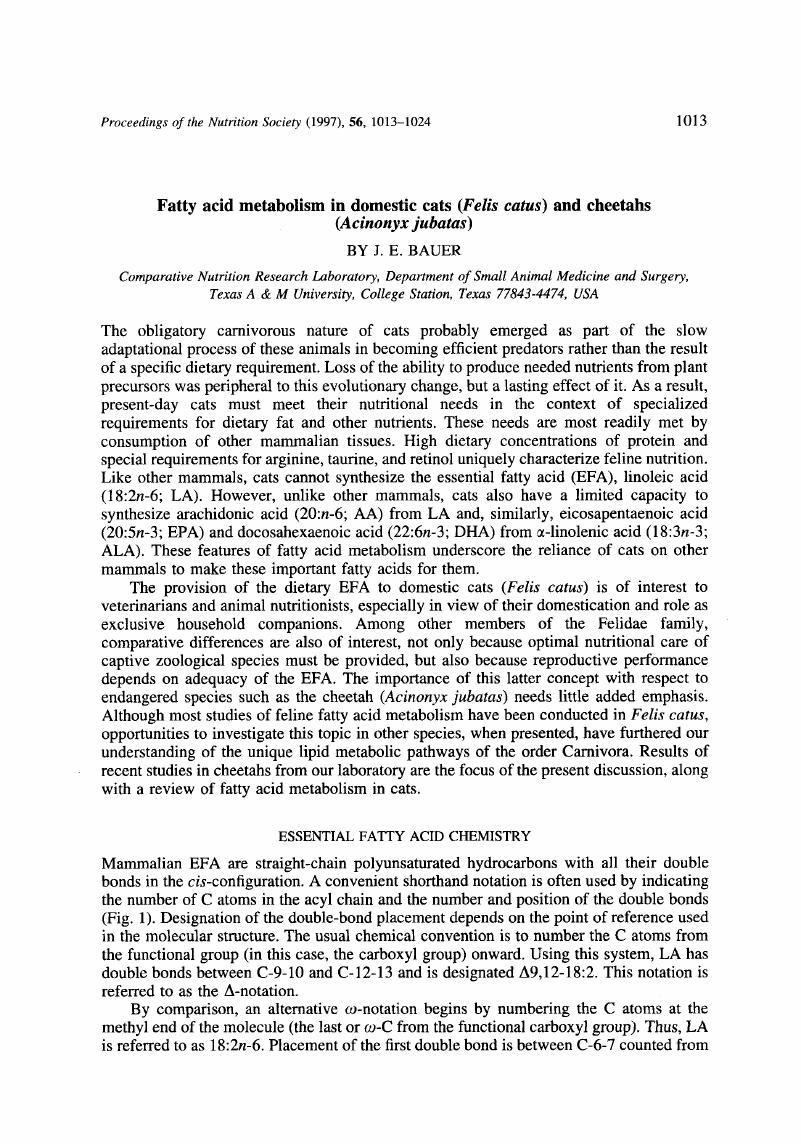Crossref Citations
This article has been cited by the following publications. This list is generated based on data provided by Crossref.
Holt, William V.
Pickard, Amanda R.
Rodger, John C.
and
Wildt, David E.
2002.
Reproductive Science and Integrated Conservation.
p.
21.
Morris, James G
2002.
Idiosyncratic nutrient requirements of cats appear to be diet-induced evolutionary adaptations.
Nutrition Research Reviews,
Vol. 15,
Issue. 01,
p.
153.
Zoran, Debra L.
2002.
The carnivore connection to nutrition in cats.
Journal of the American Veterinary Medical Association,
Vol. 221,
Issue. 11,
p.
1559.
McEvoy, Tom G.
and
Robinson, John J.
2002.
Reproductive Science and Integrated Conservation.
p.
42.
Dunbar, Brent L.
and
Bauer, John E.
2002.
Metabolism of dietary essential fatty acids and their conversion to long-chain polyunsaturated metabolites.
Journal of the American Veterinary Medical Association,
Vol. 220,
Issue. 11,
p.
1621.
Bauer, John E.
2006.
Metabolic basis for the essential nature of fatty acids and the unique dietary fatty acid requirements of cats.
Journal of the American Veterinary Medical Association,
Vol. 229,
Issue. 11,
p.
1729.
Palmquist, D.L.
2009.
Omega-3 Fatty Acids in Metabolism, Health, and Nutrition and for Modified Animal Product Foods.
The Professional Animal Scientist,
Vol. 25,
Issue. 3,
p.
207.
Bell, Katherine M.
Rutherfurd, Shane M.
Cottam, Yvette H.
and
Hendriks, Wouter H.
2011.
Evaluation of two milk replacers fed to hand‐reared cheetah cubs (Acinonyx jubatus): nutrient composition, apparent total tract digestibility, and comparison to maternal cheetah milk.
Zoo Biology,
Vol. 30,
Issue. 4,
p.
412.
Depauw, Sarah
Hesta, M.
Whitehouse‐Tedd, K.
Stagegaard, J.
Buyse, J.
and
Janssens, G. P. J.
2012.
Blood values of adult captive cheetahs (Acinonyx jubatus) fed either supplemented beef or whole rabbit carcasses.
Zoo Biology,
Vol. 31,
Issue. 6,
p.
629.
Kerr, K. R.
Beloshapka, A. N.
Morris, C. L.
Parsons, C.M.
Burke, S. L.
Utterback, P. L.
and
Swanson, K. S.
2013.
Evaluation of four raw meat diets using domestic cats, captive exotic felids, and cecectomized roosters.
Journal of Animal Science,
Vol. 91,
Issue. 1,
p.
225.
2014.
Free‐Ranging Cats.
p.
251.
Tordiffe, Adrian S. W.
Wachter, Bettina
Heinrich, Sonja K.
Reyers, Fred
Mienie, Lodewyk J.
and
Umapathy, Govindhaswamy
2016.
Comparative Serum Fatty Acid Profiles of Captive and Free-Ranging Cheetahs (Acinonyx jubatus) in Namibia.
PLOS ONE,
Vol. 11,
Issue. 12,
p.
e0167608.
Lopes-Marques, Mónica
Ozório, Rodrigo
Amaral, Ricardo
Tocher, Douglas R.
Monroig, Óscar
and
Castro, L. Filipe C.
2017.
Molecular and functional characterization of a fads2 orthologue in the Amazonian teleost, Arapaima gigas.
Comparative Biochemistry and Physiology Part B: Biochemistry and Molecular Biology,
Vol. 203,
Issue. ,
p.
84.
Whitehouse-Tedd, Katherine
Dierenfeld, Ellen S.
Becker, Anne A.M.J.
Huys, Geert
Depauw, Sarah
Kerr, Katherine R.
Williams, J. Jason
and
Janssens, Geert P.J.
2018.
Cheetahs: Biology and Conservation.
p.
365.
Scheibel, Suellen
de Oliveira, Carlos Antônio Lopes
de Alvarenga Boyd, Marianne
Pereira, Layne Carolina
Rodrigues, Darilha Mariana
Barion, Mariana Regina Lingiardi
Carbonera, Fabiana
Visentainer, Jesuí Virgílio
Huppes, Rafael Ricardo
Ribeiro, Leonir Bueno
and
Vasconcellos, Ricardo Souza
2021.
DHA from microalgae Schizochytrium spp. (Thraustochytriaceae) modifies the inflammatory response and gonadal lipid profile in domestic cats.
British Journal of Nutrition,
Vol. 126,
Issue. 2,
p.
172.
Mangiaterra, Sara
Marker, Laurie
Cerquetella, Matteo
Galosi, Livio
Marchegiani, Andrea
Gavazza, Alessandra
and
Rossi, Giacomo
2022.
Chronic Stress-Related Gastroenteric Pathology in Cheetah: Relation between Intrinsic and Extrinsic Factors.
Biology,
Vol. 11,
Issue. 4,
p.
606.
Li, Peng
and
Wu, Guoyao
2024.
Nutrition and Metabolism of Dogs and Cats.
Vol. 1446,
Issue. ,
p.
55.



